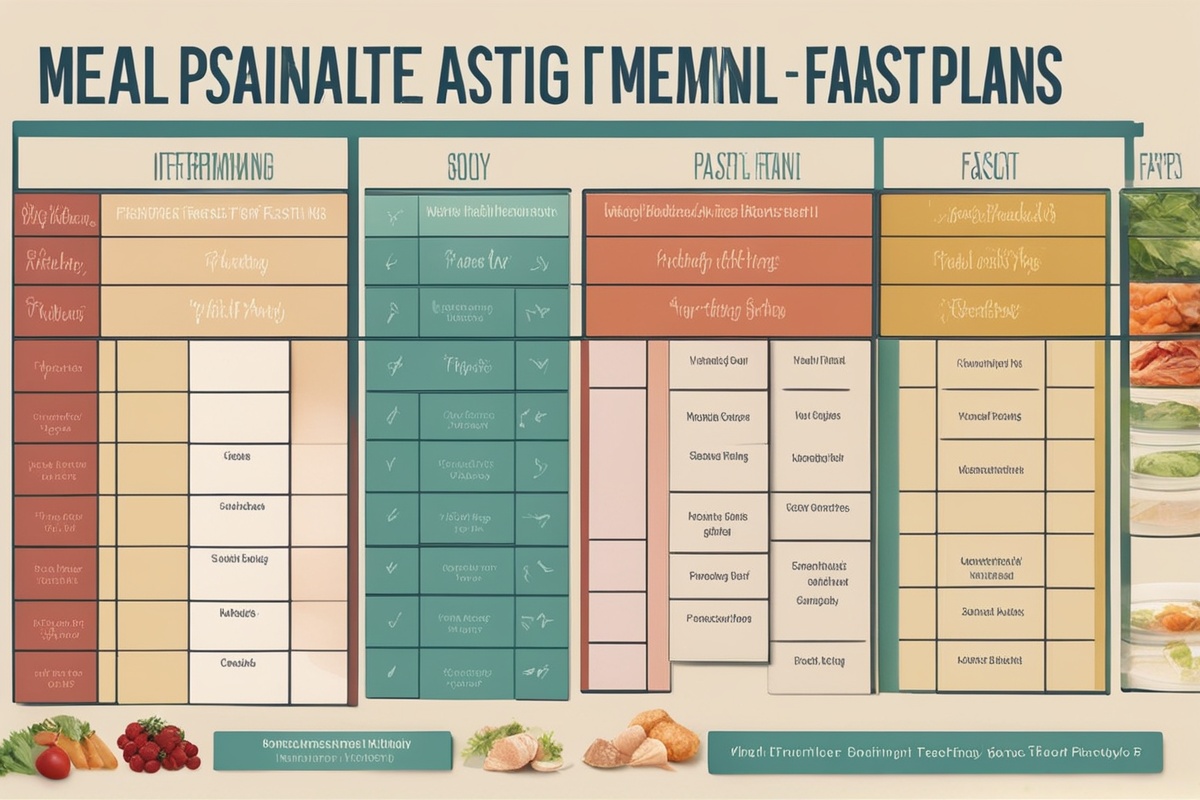Hey there, wellness seekers! If you’ve been curious about health fasting and how to make it work for your lifestyle, you’re in the right place. Fasting isn’t just a trend—it’s a practice rooted in history and backed by science for its potential to improve metabolism, mental clarity, and overall well-being. But let’s be real: diving into fasting without a plan can feel overwhelming. That’s why I’m excited to walk you through crafting effective fasting meal plans that prioritize nutrition, balance, and sustainability. Whether you’re new to fasting or looking to refine your approach, this guide will break down the essentials with practical tips and insights grounded in research. Let’s explore how fasting for health can transform your relationship with food and your body!
What Is Health Fasting, and Why Does It Matter?
When we talk about health fasting, we’re referring to the intentional practice of abstaining from food or caloric intake for a set period to promote physical and mental benefits. Unlike starvation, fasting is a controlled and often cyclical process—think intermittent fasting (IF), time-restricted eating, or even longer fasts under medical supervision. The goal? To give your body a break from constant digestion, allowing it to focus on repair and rejuvenation. Studies suggest that fasting can improve insulin sensitivity, reduce inflammation, and even support cellular cleanup through a process called autophagy (Mattson et al., 2017). But here’s the catch: fasting for wellness isn’t a one-size-fits-all deal. A solid fasting meal plan ensures you’re nourishing your body during eating windows, avoiding nutrient deficiencies, and making the process sustainable. Let’s dive into why planning matters and how it ties into successful health-focused fasting.
The Science Behind Fasting for Health Benefits
Before we get into the nitty-gritty of meal plans, let’s geek out a bit on the science of fasting for health. When you fast, your body shifts from using glucose (from food) to stored energy like glycogen and fat. After about 12–16 hours without food, your body enters a state called ketosis, where it burns fat for fuel—potentially aiding weight loss (Anton et al., 2018). Beyond that, fasting has been linked to lower blood pressure, improved brain function, and reduced oxidative stress, which contributes to aging (Longo & Mattson, 2014). One fascinating area of research is how fasting triggers autophagy, a process where cells recycle damaged components, potentially lowering the risk of diseases like cancer or Alzheimer’s (Bagherniya et al., 2018). However, fasting isn’t a magic bullet—pairing it with nutrient-dense meals during eating windows is crucial to avoid fatigue or muscle loss. That’s where a thoughtful fasting nutrition plan comes in, balancing the benefits of fasting with proper nourishment.
Types of Fasting Meal Plans to Suit Your Goals
Not all fasting protocols are created equal, and the right fasting meal plan depends on your goals—be it weight management, mental clarity, or simply resetting your eating habits. Here are some popular health fasting approaches and how to structure meals around them:
- 16/8 Intermittent Fasting: Fast for 16 hours, eat during an 8-hour window (e.g., noon to 8 p.m.). Focus on two to three balanced meals with protein, healthy fats, and complex carbs to stay satiated.
- 5:2 Diet: Eat normally for five days, then restrict to 500–600 calories on two non-consecutive days. Plan low-calorie, high-volume meals like veggie soups or salads on fasting days.
- Alternate-Day Fasting: Alternate between regular eating and very low-calorie days (or full fasts). On eating days, prioritize nutrient-dense foods to replenish energy stores.
- Time-Restricted Eating: Limit eating to a specific window daily (e.g., 6–10 hours). Meals should be evenly spaced to avoid overeating during shorter windows.
Choosing a fasting style is personal—start with something manageable like 16/8 if you’re a beginner. The key to any fasting for wellness plan is ensuring your meals support your energy needs and long-term health.
How to Build a Balanced Fasting Nutrition Plan
Okay, let’s get practical. A successful health fasting journey isn’t just about skipping meals—it’s about what you eat when you do eat. Without a plan, you might end up binging on junk food during eating windows, which defeats the purpose. Here’s how to build a fasting meal plan that works:
- Prioritize Protein:
- Load Up on Fiber: Vegetables, fruits, and whole grains keep you full longer and support gut health—crucial during limited eating windows.
- Healthy Fats Are Your Friend: Avocado, nuts, and olive oil provide sustained energy and help absorb fat-soluble vitamins.
- Stay Hydrated: Water, herbal teas, and black coffee (no sugar!) during fasting hours prevent dehydration, which can mimic hunger.
- Time Your Nutrients: Break your fast with a light meal (like a smoothie or soup) to ease digestion, then follow with a heavier, balanced meal.
For example, if you’re on a 16/8 plan, your first meal at noon might be a veggie-packed omelet with avocado, followed by a dinner of grilled salmon, quinoa, and steamed broccoli. Planning ahead prevents impulsive eating and ensures you’re getting what your body needs for fasting health benefits.
Common Pitfalls in Health Fasting and How to Avoid Them
Let’s be honest—fasting isn’t always smooth sailing, especially when you’re starting out. I’ve seen friends (and myself!) stumble with health fasting by making avoidable mistakes. One big issue is under-eating or overeating during windows, which can lead to fatigue or weight gain instead of loss. Another is ignoring hydration—fasting doesn’t mean skipping water, and dehydration can cause headaches or irritability (Popkin et al., 2010). Some folks also dive into intense fasts without easing in, shocking their system. My advice? Start slow, listen to your body, and don’t treat fasting as a punishment. If you feel dizzy or overly hungry, break your fast with a small, healthy snack. Also, avoid highly processed foods during eating windows—they spike blood sugar and leave you craving more. Stick to whole foods and monitor how you feel. Fasting for wellness should enhance your life, not drain you.
Tailoring Fasting Meal Plans to Your Unique Needs
Here’s something I can’t stress enough: there’s no universal fasting nutrition plan that works for everyone. Your age, activity level, medical history, and goals all play a role. For instance, athletes might need more carbs and protein during eating windows to fuel workouts, while someone with diabetes should consult a doctor before fasting due to blood sugar risks (Horne et al., 2015). Women may also need to adjust fasting around menstrual cycles, as hormonal shifts can affect hunger and energy. I recommend tracking your mood, energy, and hunger in a journal for the first few weeks to spot patterns. If you’re unsure, working with a dietitian can help customize a health fasting plan that aligns with your lifestyle. Remember, fasting is a tool—not a rule. Make it work for you, not the other way around.
As we wrap up, I hope you’re feeling inspired to explore health fasting with a clear roadmap in hand. Fasting meal plans aren’t about deprivation—they’re about intentional eating that supports your body’s natural rhythms. By choosing a fasting style that fits your life, focusing on nutrient-dense foods, and avoiding common pitfalls, you can unlock benefits like better energy, improved focus, and even long-term health gains. Start small, stay consistent, and don’t hesitate to tweak things as you go. Have a favorite fasting recipe or tip? Drop it in the comments—I’d love to hear how you’re making fasting for health your own. Here’s to a healthier, more mindful you!
References
- Anton, S. D., Moehl, K., Donahoo, W. T., Marosi, K., Lee, S. A., Mainous, A. G., … & Mattson, M. P. (2018). Flipping the metabolic switch: Understanding and applying the health benefits of fasting. Obesity, 26(2), 254-268.
- Bagherniya, M., Butler, A. E., Barreto, G. E., & Sahebkar, A. (2018). The effect of fasting or calorie restriction on autophagy induction: A review of the literature. Ageing Research Reviews, 47, 183-197.
- Horne, B. D., Muhlestein, J. B., & Anderson, J. L. (2015). Health effects of intermittent fasting: Hormesis or harm? A systematic review. The American Journal of Clinical Nutrition, 102(2), 464-470.
- Longo, V. D., & Mattson, M. P. (2014). Fasting: Molecular mechanisms and clinical applications. Cell Metabolism, 19(2), 181-192.
- Mattson, M. P., Longo, V. D., & Harvie, M. (2017). Impact of intermittent fasting on health and disease processes. Ageing Research Reviews, 39, 46-58.
- Popkin, B. M., D’Anci, K. E., & Rosenberg, I. H. (2010). Water, hydration, and health. Nutrition Reviews, 68(8), 439-458.
- Nutrition Reviews, 73(10), 661-674.






